Matador Network's Blog, page 714
January 19, 2021
Airbnb weekend getaways near SF

We hope you love the spaces and stays we recommend! Just so you know, Matador may collect a small commission from the links on this page if you decide to book a stay, and listed prices are accurate as of the time of publication.
A weekend away is the perfect cap to a hectic week. Few major American metropolises are better positioned to escape the traffic and chaos of the urban environment than the San Francisco Bay Area, where you can go from wine country to the coast to mountainous backcountry — all within the currently mandated 120-mile radius. And escaping the city doesn’t even have to break the bank. These unique Airbnb properties are remote and affordable.
Before we begin, let’s cover the basics. You want to relax in quiet solitude and not listen to people talk through the wall — so each of these rentals is an entire building or separated unit. You also only have a weekend and don’t want to spend half of it driving, so each is within two hours of San Francisco. Beyond those two commonalities, these properties are as diverse as they come.
Marin CountyFairy Garden Cottage, Novato
Photo: Airbnb
Price: $110/night
Distance from city: 45 minutes
Bring outdoor adventure and an artistic lifestyle together at the Fairy Garden Cottage, without going as far as Petaluma. The property is surrounded by gardens to inspire — whether that be words, paint, or what have you — and after the creativity has poured out you can relax in the private hot tub. The host, Teri, even puts the B&B in Airbnb by offering a locally sourced breakfast to her guests for an additional charge. The art garden itself is perfect for enjoying a bottle in quiet, but if you want to indulge further, many of Napa’s wineries are less than an hour away.
Airstream Bnb on Magical Property, Petaluma
Photo: Airbnb
Price: $85/night
Distance from city: 50 minutes
Airstream trailers are to road-tripping what Willie Mays is to the Giants — it just doesn’t get any better. Thing is, Airstreams are not cheap. So how about traveling to one, instead of traveling in one? At this Petaluma spot, wilderness abounds, and depending on the time of year, you may be able to glean fruit from the blackberry bushes behind the trailer. Just don’t plan to enjoy a hot cup of tea with them as the trailer only runs cold water (hot water and a full bathroom are provided inside the host’s home).
Wine countryRose Garden Charmer, Petaluma
Photo: Airbnb
Price: $150/night
Distance from city: One hour
Wine tastes best when you’re surrounded by beautiful flowers, lush hill country, and a Victorian aesthetic. The Rose Garden Charmer offers all three, with Sonoma County wine country as your backdrop. The gardens that envelope this studio are home to more than 8,000 rose bushes, a koi pond, and additional flora, and feature romantic trellised walkways. Inside, take in the charm from the clawfoot bathtub, glass in hand.
Wine Country Guest Cottage, Santa Rosa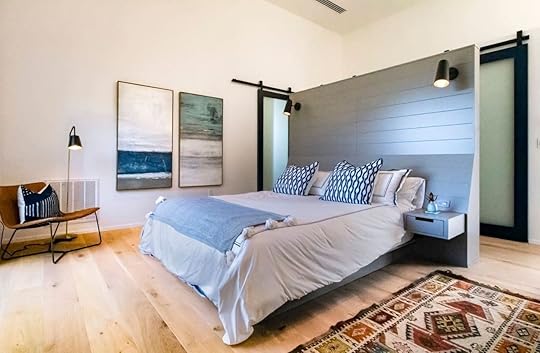
Photo: Airbnb
Price: $350/night
Distance from city: Just over an hour
This one’s a bit of a splurge, but it’s more than worth it. The Wine Country Guest Cottage is like a mini-resort in the heart of wine country. From the onsite fire pit, take in views of the surrounding valley, and after returning from wine touring soak in the in-pool spa. Sunsets are key here, so do your touring during the afternoon and grab a bottle to go. As an added bonus, you’re only 25 minutes from the coast, and that 25 minutes is populated by rolling hills and vineyards.
House on the Hill with Views, Napa Valley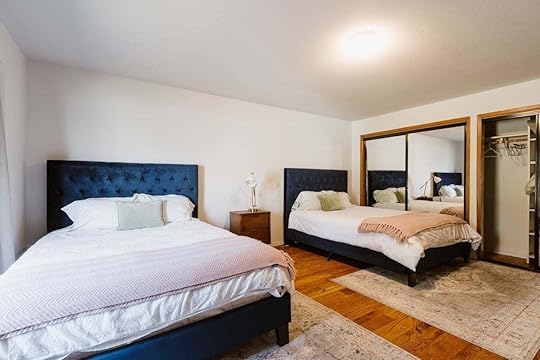
Photo: Airbnb
Price: $222/night
Distance from city: Just over an hour
This one’s perfect for an affordable group getaway. House on the Hill with Views, where the name is both simple and all-encompassing, is essentially a farm stay and a wine country basecamp rolled into one. The listing boasts “several” decks and patios on which to enjoy a glass of wine, surrounded by the vineyards on which it was produced, and when dinner beckons you can either cook onsite in the gourmet kitchen or head 10 minutes into Napa proper.
Majestic views of Sonoma wine country, Sonoma
Photo: Airbnb
Price: $329/night
Distance from city: 50 minutes
Get up high near Sonoma with this “cabin” that’s really a full-on mountain house. With incredible views of the valley below, this wine country retreat sleeps up to eight guests and is ideal for family, group, and team-building getaways. You’re surrounded by an acre of privacy but can bike or drive to Sonoma Square in minutes. The property and its epic deck offer Sonoma views and plenty of space to lounge, play games, or just relax inside in a home that actually blends rustic and modern quite well.
Pacific Coast HighwayVenture Retreat Yurt, Pescadero
Photo: Airbnb
Price: $327/night
Distance from city: 1.5 hours
Venture Retreat Yurt serves dual purposes. It’s a place to crash, yes, but it’s also a spot to recharge with space for an entire yoga retreat or mindfulness workshop. If a weekend with the crew to workshop resolutions and set intentions is in order, this yurt is the best place to do it anywhere on the Pacific Coast Highway. The host’s property also includes a hot tub and pool, yours to use as long as another retreat hasn’t rented them out privately. The ocean is nearby and the yurt is heated by a wood-burning fireplace.
The Big Om Ocean Retreat, Pescadero
Photo: Airbnb
Price: $450/night on weekends, $175/night on weeknights
Distance from city: 1.5 hours
This dome house, also in Pescadero, is right near the beach, has onsite horses, and is surrounded by ocean views. It also allows you to have plenty of space to recharge even if you come with a group (the dome sleeps up to 16 people, making the price point much more approachable). The retreat is off-grid and offline, so you won’t be tempted to check in and see what’s going on back home or have the constant temptation to Face-brag about where you’re spending the weekend.
South of the cityTranquility Base Redwood Mountain Treehouse, Felton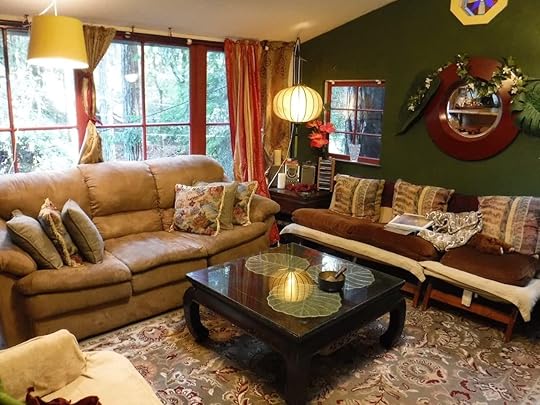
Photo: Airbnb
Price: $198/night
Distance from city: 1.5 hours
The Tranquility Base Redwood Mountain Treehouse puts you in a treehouse with the most incredible deck you’ve ever had access to. There’s a hot tub, multiple lounge areas, and a fire pit. It’s literally in the forest, so you’re up among the trees with the birds, and nearby is ample outdoor recreation at Henry Cowell’s State Park, Loch Lomond Rec Area, the Felton Covered Bridge Park, and more. If ever there were a secluded writer’s haven near the Bay, this is it.
Sanctuary in Sierra Azul Open Space Preserve, Los Gatos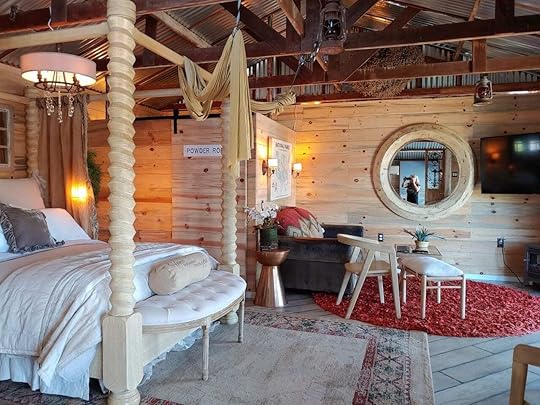
Photo: Airbnb
Price: $250/night
Distance from city: One hour
This entire cabin has cool steampunk vibes. It’s also minutes from San Jose, meaning you can bounce from your tech job and still enjoy happy hour in the middle of nowhere before watching the city lights overtake the horizon. In the morning, hit the nearby hiking trails, stretch out on the yoga swing, or lounge by the pool that is shared with an adjacent Airbnb rental on the other side of the massive property. The views from everywhere are dramatic while the inside is rustic and isolationist. Truly a place of contrasts. 
The post The most unique weekend getaways near San Francisco you can rent on Airbnb appeared first on Matador Network.

Venice’s Caffè Florian to close

Like many businesses around the world, one of Venice’s most iconic landmarks is in danger of closing due to the COVID-19 pandemic. The famous Caffè Florian in St. Mark’s Square is the oldest cafe in Italy, known for its 18th century aesthetic. It just celebrated its 300th anniversary on December 29, in fact, though it wasn’t as joyous as they might have liked due to pandemic restrictions.
Indeed, pandemic-related closures and restrictions have hit the cafe hard, with sales declining by 80 percent in 2020. While the cafe is still alive, it’s on its last legs, surviving solely thanks to the support of shareholders and financial assistance from the bank.
Marco Paolini, the managing director of the cafe, told AD, “We do everything possible to keep the business alive. We are working to stay open for as long as we can. The pandemic has affected everyone, but we couldn’t benefit from various benefits. There are no prospects for now, we don’t even know a reopening date. We are concerned about the future. If the café is closed, you wouldn’t miss just a coffee, but a piece of Venice.”

Photo: Botond Horvath/Shutterstock
The cafe originally opened in 1720 and has been a popular gathering place for hundreds of years, including artists and intellectuals like Charles Dickens, Ernest Hemingway, and Friedrich Nietzsche. It has also served as a set for various Hollywood films, including The Talented Mr. Ripley and Summertime. 
The post The oldest cafe in Italy is in danger of closing due to COVID-19 appeared first on Matador Network.

Great Blasket Island in Ireland

If you fantasize about leaving everything behind to live a rustic life on a remote, windswept island, you now have a chance to make your dream come true. Great Blasket Island, an island off the coast of Kerry in southwestern Ireland, announced via Twitter that it’s looking for either a couple or two friends to temporarily manage the island’s accommodations and coffee shop from April 1 to October 1, 2021.

Photo: Tourism Ireland

Photo: Tourism Ireland
The accommodation includes three cottages that can house up to 21 people. The caretakers will need to provide tea, coffee, and snacks to the visitors.
Although specific payment isn’t specified, the job does include food and accommodation. It does not, however, include electricity, WiFi, or hot showers.
But that doesn’t seem to deter applicants, since over 40,000 people applied last year via phone, email, and social media.

Photo: Tourism Ireland
Great Blasket Island is the largest of a group of six islands off the Dingle Peninsula and a beautiful place to hang out, but keep in mind that six months on a small, windy island might get old (and a little lonely) after a while.
To apply, fill in the online application form and email info@greatbasketislad.net for more info. You can also book an interview with former caretakers Annie and Eoin to learn more by contacting Ruth Moran at rmoran@tourismireland.com. 
A version of this article was previously published on January 15, 2020, and was updated on January 19, 2021, with more information.
More like thisRoad TripsThe 12 best things to do on road trip around Ireland’s Wild Atlantic WayThe post This iconic Irish island is looking to hire two caretakers appeared first on Matador Network.

Presidential inauguration 2021

On January 20, 2009, I watched President Barack Obama be sworn into his first term of office. I had flown out from my home in California with the Presidential Youth Leadership Conference, and “prime” wouldn’t be the word I’d use to describe our view. I had to squint to make out the outline of the main event past the many massive screens that lined the sides of the lawn in front of the US Capitol building.
I was 17, extremely unprepared for how cold DC is in January, and easily distracted by a new group of friends. I was also completely captivated by the act of having the chance to experience history first hand.
The saying that travel is about the journey not the destination doesn’t apply to things like presidential inaugurations. The inauguration is a reminder every four years that despite differing ideological stances and lifestyles, the peaceful transition of power keeps us moving forward.
This year, things are different. The Joint Congressional Committee on Inaugural Ceremonies announced in December that the 200,000 tickets that members of Congress receive to hand out to constituents was brought down to 1,000 due to the surge in COVID-19 cases. Limits were put in place to keep crowds from gathering in the usual spots in DC.
Then, on January 6, the halls of Congress were invaded by far-right extremists who planned to take hostages and stop the certification of an election that Joe Biden won by seven million votes — the second-highest popular vote margin in a US presidential election after Obama’s 10 million popular vote margin in 2008. The photos and videos from January 6 were indescribably shocking. Five people died, including one Capitol Police officer who was attacked by a rioter with a fire extinguisher. People wearing neo-Nazi clothing strolled through the halls of Congress while others kicked their feet up on desks and stole from congressional offices. The Confederate flag flew inside the building — something that actual Confederate soldiers were never able to accomplish during the Civil War.
The inauguration is now, reasonably, even more restricted as the threat of further violence looms close.
A prime-time TV special featuring Tom Hanks, Jon Bon Jovi, Demi Lovato, and other celebrities will air as a replacement to the normal cycle of balls and parties. The Presidential Inaugural Committee has put about 191,500 US flags on the National Mall to represent “the American people who are unable to travel to Washington, DC.” The presidential motorcade and other symbolic traditions will be altered significantly or scrapped entirely.

Photo: JRAphotographics/Shutterstock
This isn’t the first time the country has undergone a contentious inauguration. Herbert Hoover and Franklin D. Roosevelt, for example, had a famously uncooperative transition period, though they still followed through with a show of solidarity in the end. Trump’s inauguration in 2017 was marred by protests and marches with millions of people the following day — more, even, than the number of people who showed up for the inauguration. It’s also far from the first time that political unity seemed a far off concept. Trump, who refuses to attend the inauguration, is the first president in modern history to skip the transfer of power, but he’s not the only one. John Adams did in 1801, John Quincy Adams did in 1829, and Andrew Johnson did in 1869.
A peaceful transfer of power has historically been a defining characteristic of American democracy. Taking part and seeing it in person has been the peoples’ right, and watching one political party hand over power to another can be a unifying moment regardless of who you voted for. Yet in a year that feels more divided than ever, access is justly limited.
The myriad safety precautions are necessary in large part because of the country’s lack of leadership over the past year, starting when the first COVID-19 case was officially diagnosed in the US on January 20, 2020. Years of lies and misinformation from those in power culminated in 2020 to turn conspiracy-minded individuals into national security threats. The list of reasons why we need heightened inaugural security and lower attendance is long, as anyone who has doom-scrolled through the year knows all too well.
So Americans who can’t travel to see the inauguration will be replaced with flags and miss the opportunity to see one of the most important traditions in our democracy. This inauguration has the added historical significance as the day that Kamala Harris — the nation’s first woman, and first person of Black and South Asian descent — takes the office of vice president. Harris’s swearing in will be as much about recognition of the long road to get to this point as it is about hope for the future, which is perhaps best described by Representative Ilhan Omar and the other women who joined in a powerful USA Today op-ed.
A lack of public access doesn’t change the point of the inauguration. Biden and Harris will still be sworn in, and they will still officially start their term at noon on January 20, just like the 20th Amendment to the Constitution mandates. This also likely won’t be the last time a new US president will be forced to hold an irregular inauguration.
What’s lost is the opportunity for Americans to witness a major part of what the country stands for. Students won’t be able to attend or be in the nation’s capital for a potentially life-shaping event. Women of color who have waited their entire life to see themselves reflected in one of the highest positions of power will have to settle for a celebration mediated by screens. People of all political leanings won’t be able to personally witness the transfer of power that shows our nation will continue on like it has for centuries.
Bearing witness is one of the key parts of travel that makes being somewhere special. So much of the world is now accessible to us online, yet the draw to be present still moves people to get up and go to see events and places and moments in time in person. However, if there’s anything that 2020 taught us, it’s that sometimes traveling to see the world and the events that shape it isn’t possible. Hopefully, a restricted inauguration in 2021 means more people will be present to witness history on January 20, 2025. 
The post What we lose when we can’t travel to the inauguration appeared first on Matador Network.

The longest and scariest sled runs
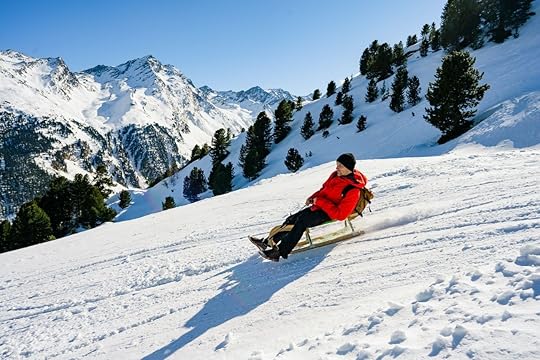
Sledding in the European Alps is serious business. It’s got nothing to do with the casual backyard or neighborhood hill activity you might be used to. In Switzerland, Austria, and France, sled runs are maintained by ski resorts or local communities, and most extend at least a mile — often several miles. Some sled runs have their own trail maps, with information on sledding conditions available on smartphone apps. A few sled runs are reached by their own dedicated gondola while others are floodlit at night, serving as a hella fun, and hella scary, way to get back to village hotel rooms after a boozy fondue dinner at a mountain-top restaurant.
Even for sled runs geared to families, these multi-mile trails cut into the sides of mountains — with drop-offs, twisting turns, and serious steeps — may prohibit kids under 14 from descending solo and kids under eight from going at all. Either way, sledding — also called sledging or tobogganing — is an activity all its own in the Alps. Whether you’re up for an out-of-control plunge down several miles of narrow mountain path or a tipsy slide after dinner, in Europe you’ll find the most thrilling sledding hills in the world.
A note on the sleds and gear
Photo: Marijs/Shutterstock
You may be used to plastic sleds made in primary colors shaped like saucers or vaguely pointed rectangles. While you might find a few of these, they aren’t suited to the sledding you’ll encounter in the Alps. Here, they prefer to stick to tradition, making sturdy sleds with wood and metal. In Switzerland, sleds are made the way they have been for centuries, with the seating area made of wood or stretched fabric and technical specifications detailed online for prospective buyers.
The straight metal runners are connected to the sides of the sled, which means that trying to lean your weight to one side or the other will have pretty much zero effect on turning it. Instead, you’ll have to use your feet in front of you or drag your hands behind you like a rudder. However, a handful of newer wooden sleds, particularly in Austria, come with the two runners attached to a vertical strut that then connects to the middle of the seat, which means that if you lean one way or the other, like on a bicycle, you’ll be able to steer a bit. Some newer sleds also have brakes, a welcome addition on these runs.
Beyond the sleds, the only gear you’ll need is warm clothes, including waterproof boots, as you’ll be using your feet to brake, and warm gloves or mittens, as you’ll be using your hands to rudder. Some sled runs require helmets, and depending on the weather, goggles may be helpful.
1. Saas-fee sledding hill
Photo: Saastal Tourismus AG
Switzerland’s Saas-Fee is one of the most breathtaking ski resorts in a mountain range full of them. Peaks seem to shoot straight up from the village, reaching heights of over 13,000 feet, while the upper slopes of the resort allow you to gaze in awe at the Fee Glacier, with its multihued layers and fearsome crevasses. Backcountry skiing in Saas-Fee transports you to a wild, white world that extends as far as you can see.
It’s no wonder then that Saas-Fee should have a sledding hill worthy of the rest of the resort, complete with its own gondola to service it. The Saas-Fee sledding trail runs six kilometers (3.7 miles) from the top of that gondola. The scariest section of the ride actually comes right at the top where you’re descending a narrow trail — with a mountainside on one side and a steep drop-off into the other.
2. Saas-Grund
Photo: Saastal Tourismus AG
Near Saas-Fee you’ll find Saas-Grund. The nearly seven-mile (11-kilometer) run there starts way up high, next to the ski runs, but then branches off and heads into the forest. It passes several small Alpine villages as it twists and turns its way down. In between the forest and villages, you’ll whizz through open spaces that lend a view of the stunning mountain range. If an 11-kilometer sled run seems like too much, you could always choose to end or start your run halfway up at the Trift cable car midstation. The top half of the run is steeper while the bottom has more variety. Might as well do the whole thing. It will “only” take you an hour and a half to descend the 3,000-plus vertical feet to the village.
3. Grindelwald, Switzerland
Photo: Jungfrau Ski Region/Facebook
In the Jungfrau ski area, you’ll find the longest sled run in the world, the big Pintenfritz, which runs 7.8 miles (12.5 kilometers) to the alpine village of Grindelwald. It’s not the only sled run that winds up in the photogenic village, but it’s the only one that starts at the very top of the 9,353-foot-high Faulhorn peak. You can consult the Grindelwald sledding map to decide which trails to zip down. The good thing about Grindelwald is that it is possible to rent sleds with brakes. Just be sure to beware of sledders behind you if you decide to slow down suddenly, as the biggest crashes aren’t usually caused by slamming into a tree off the side of the trail, but into another sledder.
4. La Tzoumaz, Switzerland
Photo: Valais/Wallis Promotion, Melody_Sky
This sledding run in French-speaking Switzerland is one of the fastest in the Alps, dropping 2,737 vertical feet in six miles. From its starting point at Savoleyres, at 7,723 feet above sea level. You’ll get sweeping views of the Rhone Valley as you head down a wide snowy area and eventually turn into the forest-lined trail and its tight switchbacks. You’ll end up back at the village of La Tzoumaz. Young kids need to go with their parents.
5. Bramberg, Austria
Photo: Wildkogel-Arena Neukirchen & Bramberg
If sledding back down to your accommodations after a cozy, wine-filled winter meal sounds appealing, but the idea of launching yourself off of the trail on a moonless night does not, then come to Bramberg, home of the longest floodlit sled run in the world. From the top of the Smaragbahn chairlift, you’ll descend 8.7 miles (14 kilometers) and more than 4,200 vertical feet to the town of Bramberg. Depending on your sledding skills, the trip could take as little as 30 minutes, but novice sledders are sure to take twice the time.
Since things can get pretty crazy, helmets are advised (and obligatory for kids), you are asked to adjust your speed where snowbanks build up on the hairpin turns, and you are only allowed to stop for a break at designated areas. There are two restaurants at the top of the sledding area — just note the warnings against alcohol-impaired sledding. A one-time descent is 13.50 euros and 6.50 for kids, or you can get a day pass and sled all day until 10 PM for just 34 euros (about $41) or 17 euros for kids.
6. Elbigenalp, Austria
Photo: kasakphoto/Shutterstock
Earning your turns isn’t only reserved for uphill skiing or heading to the backcountry. You can do it sledding, as well. To access the Bernhardseck run, you need to start in the village of Elbigenalp, hike up about 770 vertical meters (2,500 feet) to the Bernhardseck hut, which should take you over two hours. And since you’re on your own here, you are also pulling your wooden sled behind you. But the thrilling descent, dropping those same 770 vertical meters in 5.8 kilometers (3.6 miles), will be well worth the excitement. Although you’ve earned your turns, you won’t have to slog it out in backcountry powder, which as excellent as it may be on skis or a snowboard isn’t really suited for sledding. This sledding trail is groomed regularly, meaning you’ll be able to reach top speeds.
7. Schwaz, Austria
Photo: Dina Zaur.a/Shutterstock
Austria’s Tyrol region alone boasts 95 official sledding runs. The longest one in Tyrol, and the second-longest in Austria, is the Kellerjoch-Grafenast run. From the top of the Kellerjochbahn cable car, it has a combination of swooping rights and lefts with hairpin turns, ending up at the Freundsberg Castle on the edge of Schwaz, a town once made wealthy from silver mining. Those feeling good about their sledding skills might consider joining in a race on Thursday. There’s also floodlit night sledding at the lower elevations.
8. Val Thorens, France
Photo: Vladimir Golovin/Shutterstock
The longest sled run in France starts right by the Péclet glacier at a height of about 9,800 feet and drops an entire 2,300 vertical feet in under four miles, meaning it’s got plenty of steeps and not that many flat sections where you can slow down and take it easy. The track is also only 16 feet wide, so you’d better know how to control your sled. Fortunately, rentals include sleds with brakes and helmets as well. If you already have a ski pass, the gondola ride and rental will cost you 14 euros ($17) for one descent or $27 for two descents. (without a ski pass, it’s $25 and $40 for one or two descents, respectively). The sled run isn’t open late, but you can go until 6 PM, which in winter is already dark, and be rewarded with hot spiced wine at the bottom.
9. Super-Besse, France
Photo: Panthere Noire/Shutterstock
One of the most thrilling sled runs in France is not necessarily the longest. The Fantasy Luge at Super-Besse drops 1,700 feet in just 1.8 miles, which means that all the sleds have brakes, helmets are obligatory, and descents are supervised. All kids below the age of 14 have to be with an adult, and no kids under six are allowed. (Depending on snow conditions, the age limit may be raised to eight years old.) The sled run is only open after the pistes close to skiers, so your thrilling drop will happen as dusk darkens the sky. You’ll meet after hours at the La Perdrix cable car; it’s four euros (about $4.85) to ascend the car and nine euros ($11) with the sled and helmet. 
The post The world’s longest, scariest sled runs have sweeping views and hairpin turns appeared first on Matador Network.

Work from the beach in Aruba

Working from the beach sounds like a digital nomad cliché, but in Aruba, it’s entirely possible. The Boardwalk Boutique Hotel in the Caribbean island of Aruba is inviting travelers to come work from their paradisiacal beachside property and providing all the tools needed to work efficiently.
The hotel has installed new workstations for guests, which come as a reserved beach hut with views of the ocean. There are also private poolside desks under palm trees, all of which are free of charge. Both the desks and workstations are available on a first-come, first-served basis and equipped with WiFi and a comfortable chair, in case you weren’t relaxed enough already.
According to a statement from hotel co-owner Kimberly Rooijakkers, “Our guests typically come to Boardwalk to enjoy the tranquility on our lush property, the spacious casitas with extras like a private patio, a full kitchen, even a private plunge pool or outdoor shower — things that in the new reality add extra value when searching for a healthy and safe vacation environment. The new outdoor workstations we’ve created add to that new reality and integrate Aruba’s beautiful surroundings and nature with our guests’ needs to get some work done while enjoying their stay in Aruba.”
The hotel’s initiative aligns well with Aruba’s One Happy Workstation program, designed to attract remote workers with 90-day visa-free stays. 
The post This Aruba hotel is inviting you to work from the beach appeared first on Matador Network.

Empire State Trail open

Americans are not able to cross the Canadian border right now, but at least they can walk and bike right up to the edge thanks to this new trail. The Empire State Trail is a 750-mile-long hiking and cycling path across New York, going all the way from New York City to the Canadian border, and from Lake Erie to the Capital District, and it just opened at the beginning of this year.
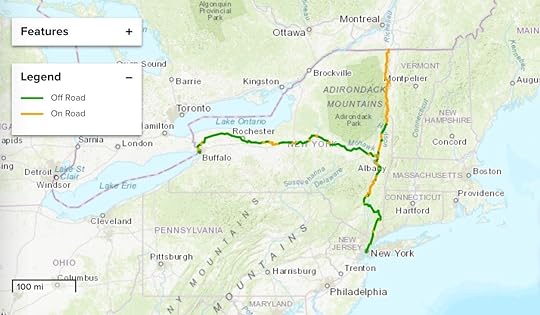
Photo: Empire State Trail
The project, which was announced in 2017, has just been completed. It builds on two existing but previously disconnected trails with 350 miles of new paths connecting near Albany. It consists of three sections called the Hudson Valley Greenway (linking NYC to Albany), the Erie Canalway Trail (between Buffalo and Albany), and the Champlain Valley Trail (between the Capital District and the Canadian border south of Montreal). Nearly nine million residents and tourists are projected to visit the trail each year.
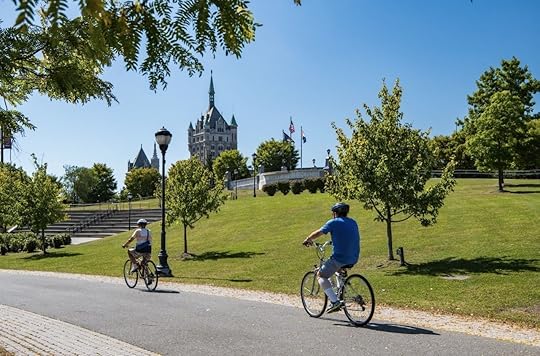
Photo: Empire State Trail
When New York Governor Andrew Cuomo announced the trail’s construction in 2017, he said, “The Empire State Trail, once completed, will be the nation’s largest state multi-use trail network, providing residents and visitors alike unprecedented access to New York’s outdoor treasures, driving tourism and economic activity to communities across the state and helping to protect our environmental resources for generations to come.”
For more information about the Empire State Trail, including a map and suggested activities, check out the official website. 
A version of this article was previously published on November 3, 2020, and was updated on January 19, 2021, with more information.
More like thisCyclingThe 7 most epic bike tours around the worldThe post This 750-mile trail from New York City to Canada is now open appeared first on Matador Network.

Drinks to avoid on a plane

There are a lot of strong opinions about the best drinks to have on a plane and what, exactly, you should consume and what you should avoid. A flight attendant is taking to TikTok to put some of those beverage myths to rest — and put all passengers on notice for the next time they fly.
In a TikTok video, flight attendant Kat Kalamani revealed a few things you should never consume on an airplane.
“Rule number one,” she says, “never consume any liquid that is not in a can or a bottle.” She explains that the water tanks are never cleaned, and that flight attendants rarely drink coffee and tea because the water comes from the same water tank, calling it “absolutely disgusting.”
Kalamani goes on to explain how the coffee machines are rarely cleaned unless they’re broken and need to be repaired. A good tip for parents is to “never ask for hot water and put it in your baby’s bottle. Ask for a bottle of water on the side and hot water in a cup, then make your baby a bottle with the bottled water and put it in the cup and heat it up.”
She doesn’t address the burning questions of “is it safe to order the fish?” or “do they water down the drinks?” but maybe those will be addressed in a future video. 
The post What not to drink on a plane, according to a flight attendant on TikTok appeared first on Matador Network.

Michelin-starred vegan restaurant

It didn’t take long for 2021 to start setting records. For the first time ever in France, a vegan restaurant has been awarded a Michelin star. The restaurant ONA — it stands for Origine Non Animale — in Arès, France, serves only animal-free dishes.
Claire Vallée, who runs the restaurant, said, “It felt like I got hit by a train” when she learned she would be receiving a Michelin star. She also won a green star, a new award introduced by Michelin last year for establishments with a strong record for ethical practices.
There are seven dishes on Vallee’s gourmet menu, her favorite one consisting of pine, boletus, mushroom, and sake or celery, tonka, and amber ale. The restaurant serves meals on a green terrace and has a garden with over 140 plants.

Photo: ONA Restaurant/Facebook
Vallée was inspired by her travels, especially in Thailand, telling ABC News, “I bring back spices, cooking methods, vegetables that I would not have seen.”
At first, Vallée had trouble securing funding for her restaurant, with traditional French banks skeptical of the success of an all-vegan restaurant. She eventually obtained the funds through crowdfunding and through La Nef, a bank specializing in lending to ethical projects. 
The post Vegan restaurant in France gets Michelin star for the first time ever appeared first on Matador Network.

January 15, 2021
Brazilians are going vegan
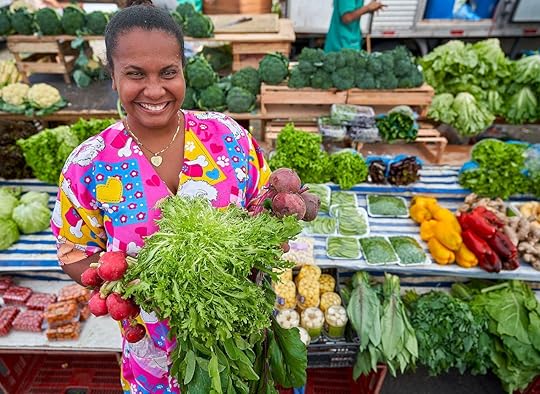
“We don’t put a plate of food on the table. We put a way of life,” says Tati Lund, who founded .Org Bistro, one of the first vegan restaurants in Rio de Janeiro, Brazil, a decade ago.
Thirty-three-year-old Lund says that when she started her restaurant, though, plant-based diets weren’t as well understood in Brazil. “Here in Brazil, it wasn’t something as well developed as it is today… So I opened saying it was an organic restaurant. Then people came and they realized it was all vegan,” says Lund.
Today, the effects of pioneers like Lund can be seen in the markedly different attitudes about meat-free eating. “Today it’s super cool,” says Lund of veganism in Brazil, using the words “super cool” in English to mean “hip” or “trendy,” although the rest of our conversation is in Portuguese.
In fact, meat-free eating has become so “super cool” that in 2018, a study funded in part by the Brazilian Vegetarian Society, or SVB by its Brazilian initials, showed that 14 percent of Brazilians consider themselves vegan or vegetarian, a 75 percent increase in six years. Not only is that percentage even higher in Brazil’s big cities, but it appears to have increased significantly even since then.
That’s huge news for a country that is the world’s largest exporter of beef and where meat is such a central part of the culture.
“Brazil has a huge culture of meat consumption,” says Alessandra Luglio, a nutritionist who works with well-known clients and directs the Brazilian Vegetarian Society’s department of health and nutrition. “Meat is a part of our typical plates like feijoada, churrasco — that’s very traditional in Brazilian culture.”

Photo: Org Bistrô/Facebook
Despite meat’s centrality to the Brazilian lifestyle, Luglio, who is vegan, says she’s seen a big change in how vegetarians are perceived in her country. “Some years back, people had a lot of preconceptions about vegetarians. At first, they judged vegetarians as being activists, extremists, radicals. We saw those adjectives a lot,” she says. “Now most people accept vegetarians as ‘normal.’”
It’s a change that has come swiftly. “If you had asked me in 2019, no matter how optimistic I felt, I would not have expected the change we see today, so many companies creating vegan options,” says Luglio.
As a nutritionist, Luglio points to studies showing that the main motivation for the move away from meat is a health-driven one. Maria Eduarda Lemos, the director of certification at the Brazilian Vegetarian Society, agrees, noting that a 2018 study by the Good Food Institute showed that “59 percent of Brazilians interviewed said health was a decisive factor in their decision to reduce their consumption of meat.”

Photo: Org Bistrô/Facebook
That said, Lemos feels that the events of last year in Brazil have also raised awareness of the environmental impact of meat consumption. “Today, principally with the pandemic, I think people are more concerned and aware of how impactful the consumption of animal protein is not just to their own health but to the environment,” she says.
Referring to fires that raged in the Amazon for weeks and massive deforestation that actually accelerated during the pandemic, Lemos adds, “I believe before people worried more about health and then there was a focus on the environment, principally for what happened last year in our country, with the Amazon and the Pantanal.”
Lemos is responsible for certifying that foods — and increasingly cosmetics, cleaning products, clothes, and shoes — are vegan. She says SVB created the vegan seal eight years ago, but that the interest in it has increased multifold in the last year alone.
“The change in Brazilian consumers’ awareness about their eating habits is palpable,” she says. In a rush to address that demand, Brazilian companies have embraced the SVB vegan seal. “We’ve seen a growing demand for the certification from a third party that guarantees that their products are vegan,” says Lemos.
And Lemos is busy, given the sheer number of food manufacturers in Brazil. Brazil is not just the world’s largest exporter of beef but a huge producer of other foodstuffs as well, from soy to oranges. These producers want to capitalize on the demand in their country and abroad for meat-free proteins. Less than two years ago, the Brazilian company Mantiqueira, the largest egg producer in South America, created a vegan egg that comes in a carton just like the classic lain eggs.
That’s not surprising. Those I spoke with said that while Brazilians are looking for more plant-based foods, many are first seeking meat substitutes.
“Everyone has their own process and their own time to adapt to new experiences,” notes Lemos of the move away from meat — but it’s a change that she says is essential to get companies to continue developing alternatives to meat-based protein. “The change we want to see starts with us,” says Lemos.

Photo: Roberto Epifanio/Shutterstock
As nutritionist Luglio sees it, these meat substitutes are an important first step. Even though a vegetarian diet based on whole foods, rather than on processed foods, is healthier, she says that getting people off of meat, however that happens, is beneficial.
“I see it as all very positive,” says Luglio, adding that in her city of São Paulo, which has a notable Japanese influence, two of its many Japanese restaurants are fully vegan. Likewise, nearly all of its pizzerias and lunch spots all offer meat-free alternatives with vegan cheese or vegan hamburgers.
“The substitute, plant-based meat, is a passport, not the actual thing,” says Luglio. “Day by day the person will reduce the substitute and eat less meat and they’ll eat more grains, beans, peas, lentils.”
Moreover, says Luglio, the huge demand for vegetarian products is being addressed in part by Brazilian companies that are big in the international market. In that way, says Luglio, Brazil can serve as a “reference point” for aspiring vegetarians outside the country as well.
One Brazilian company rushing to meet that demand is The New Butchers, a São Paulo-based “FoodTech” upstart that grew 60 percent during the pandemic while selling plant-based products called The New Chicken 2.0, The New Chicken Burger, and The New Burger.
The New Butchers’ CEO, Bruno Fonseca, told me by email that, “Our consumers are the flexitarians, people who like to eat meat or who grew up with this habit, but who want to reduce consumption for some reason such as health, concern with the environment, or concern for animals.”

Photo: The New Butchers
Fonseca, whose own veganism was motivated by concerns for animal welfare, says his product allows Brazilians to continue their way of life. “In Brazil, our culture is having a barbecue with friends on the weekends, and we don’t want that to cease existing. We just want to offer a clear and more healthy alternative to animal protein.”
The New Butchers’ products are made with pea protein and coconut fat, without gluten or added sugars. It’s notable that soy products aren’t used, since Brazil’s massive monoculture soy plantations are also blamed for biodiversity loss in the country.
Certainly, the acute need to move away from meat has been stressed by such renowned environmentalists as Sir David Attenborough, who says that we need to stop feeding the world with meat.
But in Brazil, the smoke-choked air of its big cities from forest fires, the increasing droughts produced by the destruction of its wetlands, and the egregious policies of its right-wing president Jair Bolsonaro — one of the world’s autocratic leaders who’s used the destruction of the planet as a political power tool — have made the problem feel much more urgent and tangible.
The primacy of cattle ranching in the destruction of the Amazon rainforest is well documented, and it’s one that motivates people like Lund of .Org.
“Everybody knows the principal cause of deforestation is livestock. We didn’t make that connection [in the past]: the consumption of meat with destruction, deforestation. It’s increasingly obvious now,” says Lund.
Lund notes with dismay that Bolsonaro’s environmental minister was heard saying last year that, while journalists were focused on the pandemic, they should “let the cattle pass” into these endangered areas.
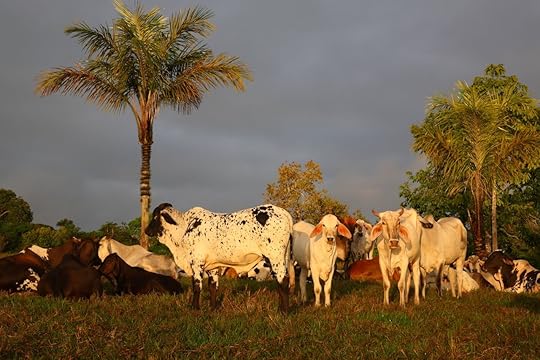
Photo: CYSUN/Shutterstock
For her part, Lund wants not just to show that a meat-free diet can be healthy and delicious, but that it can also be economically viable. Beyond emphasizing products from local producers and small farmers on her daily changing menu, Lund also likes to focus on foods that are sustainable and an important part of the Brazilian diet like cassava.
She also has dinners focused on plants from the Amazon, to show that “we can produce foods from the [rain]forest intact as it is. We don’t need to deforest it, to bring in livestock, soy, and all that.”
For Lund, her restaurant is more than a business. She sees it as a movement and as a school, to educate Brazilians and change their minds about a meatless lifestyle. Today she has the help of Brazilian stars like Xuxa Meneghel, formerly married to Pelé and a huge daytime celebrity for many years, who has been loudly espousing veganism on her social media channels for two years.
Brazilian singer Anitta has also become vegan. And earlier this month, surfer Gabriel Medina, a world champion, announced his decision to give up meat and urged his eight million Instagram followers to do the same.
Of course, Lund, like Loglia and others, recognizes that in a society with such income inequality as Brazil, there are members who do not have the luxury of deciding what to eat. “There are so many people below the poverty line who have no way to think about what to eat. They are essentially eating to survive,” she says.
But given how simple changing your diet is compared to, say, moving to renewable energy or reducing emissions, which require government involvement, Lund says it’s really imperative that we think about what is on our plate.
Says Lund, “For the person who has an opportunity to think when they eat, for them it’s our obligation to change, to take a new approach to nutrition so that our biodiversity isn’t lost so quickly.” 
The post More Brazilians are giving up meat, and that’s great news for the planet appeared first on Matador Network.

Matador Network's Blog
- Matador Network's profile
- 6 followers



